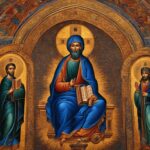St. Pachomius, also known as Saint Pachomius the Great, is a revered figure in the history of Christianity. Born in the fourth century in Thebaid, Roman Egypt, he went on to establish the foundations of communal monasticism. His visionary approach and dedication to his faith have left an indelible mark on the world of Christian spirituality.
St. Pachomius’ journey began in a pagan family in Thebaid, Roman Egypt, near modern-day Luxor. However, his path took a transformative turn when he encountered local Christians during his service in the Roman army. Inspired by their compassion and devotion, he sought a deeper understanding of Christianity and ultimately embraced the faith.
With a newfound commitment to religious life, St. Pachomius delved into the world of ascetics and hermits, seeking wisdom and guidance. Under the mentorship of the hermit named Palaemon, his spirituality flourished, and he developed a unique devotion to prayer, including the practice of praying with arms outstretched in the form of a cross.
Drawing inspiration from the renowned desert father, St. Anthony of Egypt, St. Pachomius desired to lead a hermit’s life. However, a divine voice led him to establish the first cenobitic monastery at Tabennisi, Egypt, between 318 and 323. This marked the beginning of his pioneering approach to communal monasticism.
St. Pachomius’ monastery at Tabennisi served as a model for other monastic communities, as he emphasized the harmonious integration of prayer, work, and communal living. His leadership and organizational skills enabled the growth and success of these communities, transforming the lives of Christian monks throughout the fourth century.
Despite the profound impact of St. Pachomius’ work, he faced challenges and criticisms from those who favored a more solitary, eremitic lifestyle. Some believed that communal living detracted from the spiritual focus of monasticism. Additionally, St. Pachomius defended orthodoxy against the heretical movement of Arianism, further drawing scrutiny and opposition.
Following his death, St. Pachomius was venerated as a saint, with his feast day celebrated on May 9 in the Coptic Orthodox Church and on May 15 in other Christian traditions. His spiritual gifts, including the ability to speak languages he had never learned, contributed to his path to sainthood and the enduring legacy he left behind.
Key Takeaways:
- St. Pachomius is recognized as the father of communal monasticism in Christianity.
- He was born in Thebaid, Roman Egypt, in the fourth century.
- After encountering Christians during his time in the Roman army, he converted to Christianity.
- St. Pachomius established the first cenobitic monastery at Tabennisi, Egypt, and promoted a balanced integration of prayer, work, and communal living.
- Despite challenges and criticisms, St. Pachomius’ contributions to Christian monasticism were widely recognized, and he is venerated as a saint.
Early Life and Background
St. Pachomius, the Father of Communal Monasticism, was born around 290 in Thebaid, Roman Egypt, near modern-day Luxor. He came from a pagan family and experienced a traditional upbringing. At the age of 21, Pachomius was conscripted into the Roman army. Though he never saw battle, his time in the army proved to be significant in shaping his future.
During his military service, Pachomius encountered local Christians who showed him kindness and provided him with food and comfort. This encounter left a deep impression on him and marked the beginning of his spiritual journey.
“It was through the compassion and generosity of these Christians that I first encountered the love and grace of God. Their selflessness and dedication opened my eyes to a different way of life, a life centered around faith and compassion.”
These experiences planted the seeds of faith within Pachomius and ignited a desire to further explore Christianity.

Call to Religious Life
While serving in the Roman army, St. Pachomius felt a strong inner calling to explore Christianity. The experiences he had during his time in the army, especially the kindness shown to him by local Christians in Thebes, sparked his interest and curiosity about this new faith. After being discharged from the army, Pachomius experienced a profound conversion and decided to fully commit himself to the Christian way of life.
After his baptism, Pachomius sought guidance from ascetics and hermits, eager to deepen his understanding of the Christian faith. It was during this search for spiritual wisdom that he encountered a hermit named Palaemon, who would become his mentor and guide. Under Palaemon’s wise instruction, Pachomius delved into the practice of prayer, developing a deep devotion to communing with God.
One particular form of prayer that Pachomius adopted was the practice of stretching out his arms in the shape of a cross. This symbolic act represented his complete surrender to God and his willingness to embrace the path of discipleship. Pachomius found solace and strength in this physical expression of his faith, helping him to grow closer to God in his spiritual journey.
“By praying with outstretched arms, I open myself to the divine presence and surrender my entire being to God’s will. This gesture reminds me of the sacrifice Christ made on the cross and calls me to imitate His selfless love.”
Pachomius’s call to religious life was a transformative moment that set him on a path of discipleship and service. His baptism marked the beginning of his journey as a committed Christian, which would ultimately lead him to become a renowned saint and the founder of Christian monasticism.

| Conversion to Christianity | Mentorship and Spiritual Growth | The Symbolism of the Cross |
|---|---|---|
| After being discharged from the Roman army, Pachomius received the sacrament of baptism and embraced the Christian faith. | Pachomius sought guidance from ascetics and hermits, eventually finding mentorship under the hermit named Palaemon. | The practice of praying with outstretched arms in the shape of a cross became a central part of Pachomius’s prayer life, representing his complete surrender to God. |
Work
After spending time as a hermit, St. Pachomius felt drawn towards the practices of St. Anthony of Egypt and aspired to live near him. However, during his stay in Tabennisi, Pachomius received a divine instruction to build a dwelling for hermits to gather. Responding to this spiritual calling, Pachomius established his first monastery between 318 and 323 in Tabennisi, Egypt.
Not content with just one monastery, Pachomius went on to found another in Pbow. Displaying exceptional organizational skills, he gathered a community of monks who lived together and held their property in common under his wise and compassionate leadership. This communal lifestyle enabled the monks to support one another, fostering a spirit of unity and devotion.
“In building these monasteries, St. Pachomius created not just physical spaces, but also vibrant communities where monks could live harmoniously, immersed in both prayer and work.”
Under Pachomius’s guidance, the monastic communities flourished, becoming beacons of spiritual growth and discipline. Through his visionary approach to communal monasticism, St. Pachomius paved the way for the development of countless monastic communities, inspiring generations of monks to live a life centered on prayer, work, and communal living.

The Impact of Organizational Skills
Pachomius’s organizational skills played a vital role in the success of the monastic communities he founded. His ability to create structured environments allowed the monks to live in harmony, effectively managing their daily tasks, schedules, and responsibilities. The efficiency and orderliness fostered by Pachomius’s organizational skills contributed to the spiritual growth and stability of the communities.
Spiritual Life and Philosophy
St. Pachomius placed great emphasis on the spiritual aspects of monastic life, guiding his followers through a philosophy rooted in prayer, work, communal living, and asceticism.
Prayer and Spiritual Exercises
Pachomius recognized prayer as the foundation of a monk’s spiritual journey. He encouraged his disciples to engage in regular and fervent prayer, seeking union with God and seeking divine guidance. The practice of spiritual exercises, such as contemplation, meditation, and chanting psalms, fostered a deep connection with the divine.
Work and Fulfillment of Responsibilities
For Pachomius, prayer and work went hand in hand. He believed that productive labor complemented the spiritual life, offering monks a sense of purpose and fulfillment. Each member of the community had assigned tasks and responsibilities, contributing to the communal welfare and supporting the sustenance of the monastery. Through their work, the monks practiced humility, obedience, and diligence.
Communal Living and Mutual Support
Pachomius emphasized the significance of communal living in the monastic context. Living together allowed the monks to support and inspire one another on their spiritual journeys. They shared meals, engaged in communal prayer, and participated in spiritual discussions, fostering a sense of unity and brotherhood. In the communal setting, the monks learned to cultivate virtues such as patience, tolerance, and compassion.
Integration of Asceticism and Daily Life
Pachomius integrated asceticism into the daily lives of his followers. While embracing simplicity and self-denial, he emphasized the importance of moderation and balance. The monks practiced fasting, abstinence, and other forms of self-discipline as a means of nurturing spiritual growth and detachment from worldly desires. Pachomius believed that true asceticism was not about harsh treatment of the body but rather a transformative inward journey.
“Let us labor and do everything according to the commandments of God, and the Lord shall reveal to us His way, each according to the measure of his humility.”
St. Pachomius’s spiritual philosophy aimed to cultivate a harmonious balance between devotion to God, productive work, communal harmony, and disciplined living. His teachings continue to inspire individuals seeking a profound spiritual connection and a life of purpose.

Challenges and Criticisms
In his pursuit of communal monasticism, St. Pachomius encountered challenges and criticisms from monks who favored the traditional eremitic lifestyle. These monks were hesitant to embrace the communal way of life, finding it distracting and less conducive to their individual spiritual pursuits. However, St. Pachomius remained steadfast in his commitment to his monastic vision, envisioning a community where monks could support and inspire each other on their spiritual journeys.
“The distractions of communal living can be overwhelming, pulling us away from our personal devotion and contemplation,” said one monk who preferred the eremitic life. “It is difficult to find the solitude and silence necessary for deep spiritual growth amidst the bustling activity of a monastery.”
Despite the criticisms, St. Pachomius recognized the value of communal living as a means to cultivate a strong sense of community and shared spirituality. He believed that the distractions and challenges of communal life could be transformed into opportunities for growth and mutual support.
Furthermore, St. Pachomius faced criticism for his defense of orthodoxy against Arianism, a heretical movement that denied the divinity of Christ. His steadfast commitment to the teachings of the Church and his willingness to defend the truth sparked controversy among some, who accused him of being too rigid and inflexible.
“St. Pachomius’s unwavering devotion to orthodoxy is commendable, but some argue that he lacked openness to alternative perspectives,” noted a contemporary theologian. “His strong stance against Arianism may have alienated some individuals who sought a more inclusive and open-minded approach.”
However, St. Pachomius believed that preserving the orthodox faith was essential for the spiritual well-being of the monastic community. His determination to uphold the teachings of the Church and combat heresy shaped the foundation of his monastic communities and influenced subsequent generations of monks.

St. Pachomius’s resilience in the face of challenges and criticisms allows us to reflect on the complexity of communal living and the importance of staying true to our beliefs. While eremitic life offers solitude and focus, communal monasticism provides a supportive and nurturing environment for monks to grow together in their spiritual journey. It is through this delicate balance and commitment to orthodoxy that St. Pachomius’s legacy continues to inspire and guide monastic communities around the world.
Recognition and Awards
After his death on May 9, 348, St. Pachomius was honored and recognized as a saint by various Christian traditions. His remarkable contributions to the development of monasticism solidified his enduring legacy. The feast day of St. Pachomius is celebrated on May 9 in the Coptic Orthodox Church and on May 15 in the Roman Catholic, Eastern Orthodox, and Anglican Churches.
St. Pachomius is revered for his spiritual gifts and profound influence on Christian devotion. His ability to communicate in languages he had never learned demonstrated his exceptional spiritual connection. Furthermore, St. Pachomius advocated for the use of a prayer rope in Christian devotion, a practice that has since become widely adopted in various religious communities.
| Feast Day | Churches |
|---|---|
| May 9 | Coptic Orthodox Church |
| May 15 | Roman Catholic, Eastern Orthodox, and Anglican Churches |
Miracles and Path to Sainthood
St. Pachomius was not only a holy man but also a vessel for extraordinary miracles, which further solidified his enduring reputation. One of the most remarkable miracles attributed to him was his ability to speak languages he had never learned. This extraordinary gift was seen as a divine sign of his close connection to the spiritual realm and his profound wisdom.
Throughout his life, St. Pachomius performed numerous miracles that demonstrated his divine favor. These miracles ranged from healing the sick and injured to calming storms and providing nourishment in times of scarcity. The profound impact of these miracles on the lives of the people he encountered solidified his status as a holy man and fueled the devotion of his followers.
“His miracles were seen as powerful testimonies to his sanctity and divine grace. They served as tangible evidence of his close relationship with God and his unwavering faith.”
The path to sainthood for St. Pachomius was paved with these miracles and the unwavering faith of those who witnessed them. His spiritual gifts and the profound impact of his monastic communities were instrumental in his recognition as a saint by various Christian traditions. The enduring reputation of St. Pachomius as a holy man continues to inspire generations of believers to seek a deeper connection with God and embrace a life of devotion and service.
Miracles Attributed to St. Pachomius
| Miracle | Description |
|---|---|
| Miracle of Language | St. Pachomius was able to fluently speak languages he had never learned, a manifestation of his divine connection and wisdom. |
| Healing the Sick | Through his prayers, St. Pachomius healed numerous individuals suffering from various afflictions, bringing hope and relief to the sick and their loved ones. |
| Miracles of Provision | During times of scarcity, St. Pachomius miraculously provided food and nourishment for his monastic communities, ensuring their survival and well-being. |
| Calming Storms | Through his faith and prayers, St. Pachomius calmed violent storms and protected those at sea, demonstrating his divine authority over the forces of nature. |
These miracles, among many others, are testaments to the extraordinary nature of St. Pachomius’s spiritual power and his unwavering commitment to serving God and his fellow human beings.
Legacy and Continuing Influence
St. Pachomius’s legacy is undeniably profound, with a lasting impact on monastic communities and Christian spirituality. His innovative approach to communal monasticism laid the foundation for the development of monasticism in various traditions. The monastic communities he established thrived under his guidance, and their influence spread far and wide, shaping the practice of Christian spirituality.
One of St. Pachomius’s greatest contributions was the balance he achieved between prayer, work, and communal living. This holistic approach to spiritual life continues to inspire countless individuals today. The notion that diligent work and dedicated communal living can be complementary to a vibrant prayer life remains a central tenet of Christian spirituality. St. Pachomius’s example teaches us that spiritual growth can be nurtured within the context of everyday life.
Alongside his enduring legacy, St. Pachomius faced challenges and criticisms. Some monks were resistant to the communal way of life he advocated, preferring the solitude and simplicity of eremitic monasticism. Despite these challenges, St. Pachomius remained steadfast in his commitment to his vision. His unwavering faith and dedication to the communal model of monasticism have greatly influenced subsequent generations of monks and nuns, helping to sustain the rich tradition of Christian spirituality.
Today, St. Pachomius’s legacy continues to inspire and guide individuals seeking a deeper connection with their faith. The principles he established of communal living, balanced with prayer and work, have become a cornerstone of Christian spirituality. His teachings remind us that a disciplined and committed Christian life can be lived in community, providing support and encouragement along the spiritual journey.
FAQ
Who is St. Pachomius?
St. Pachomius, also known as Saint Pachomius the Great, is recognized as the founder of Christian cenobitic monasticism. He was an Egyptian saint who lived in the 4th century and established the first cenobitic monastery at Tabennisi, Egypt.
What is cenobitic monasticism?
Cenobitic monasticism is a form of monasticism in which individuals live in a community, sharing their resources and living according to a set of common rules. St. Pachomius’s innovative approach to communal living became the basis for monastic communities throughout the Christian world.
What is the Pachomian Rule?
The Pachomian Rule, established by St. Pachomius, is a set of guidelines for communal monastic living. It emphasizes the balance between prayer, work, and communal living, providing a framework for the spiritual development of Christian monks.
What influenced St. Pachomius’s decision to become a monk?
After being discharged from the Roman army, St. Pachomius sought guidance from ascetics and hermits. He was particularly influenced by the practices of St. Anthony of Egypt and felt called to dedicate his life to God through monasticism.
How did St. Pachomius organize his monastic communities?
St. Pachomius showed exceptional organizational skills and gathered a community of monks who lived together and held their property in common. He established his first monastery at Tabennisi and later founded another at Pbow.
What was St. Pachomius’s approach to monasticism?
St. Pachomius emphasized the importance of spiritual exercises, balancing prayer and work within the community. He believed in the value of communal living, where monks could support and inspire each other on their spiritual journeys.
Did St. Pachomius face any challenges?
Yes, St. Pachomius faced challenges and criticisms from monks who preferred the traditional eremitic lifestyle. Some found communal living distracting and less conducive to their spiritual pursuits. Additionally, he encountered criticism for his defense of orthodoxy against the heretical movement known as Arianism.
How is St. Pachomius recognized in the Christian world?
After his death, St. Pachomius was venerated as a saint by various Christian traditions. His feast day is celebrated on different dates in different churches, including May 9 in the Coptic Orthodox Church and May 15 in the Roman Catholic, Eastern Orthodox, and Anglican Churches.
What is St. Pachomius’s legacy?
St. Pachomius’s innovation of communal monasticism laid the foundation for the development of monasticism in various traditions. His ideas and practices influenced the development of monasticism beyond Egypt, spreading to Palestine, Syria, North Africa, and eventually Western Europe.
How does St. Pachomius continue to inspire people today?
St. Pachomius’s approach to living a committed and disciplined Christian life continues to inspire countless individuals. His emphasis on prayer, work, and communal living remains a significant aspect of Christian spirituality, guiding people in their spiritual journeys.
















